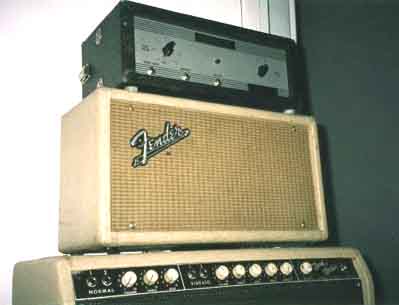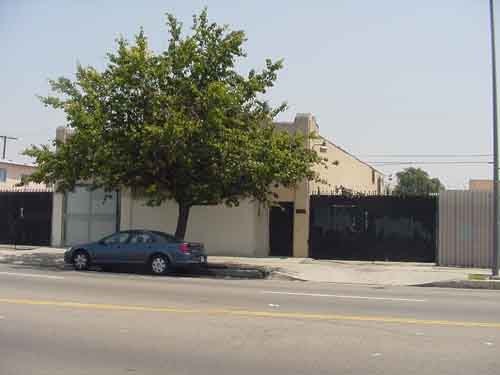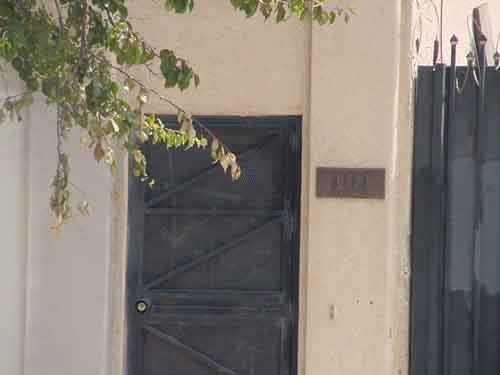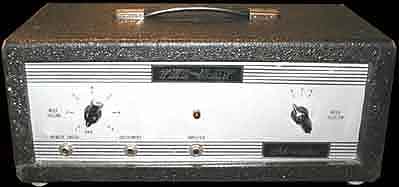
TEL-RAY is a long-forgotten California electronics
company that made "tape-less echo effects" in the 60's, before analog delay pedals existed.
The mastermind behind this space-age approach to delay effects Tel-Ray's head
honcho, Ray Lubow.
Instead of tape, "Adineko Memory System" used what looks like a tuna
can filled with electrolytic oil. A tiny motor pulls
a miniature rubber belt, spinning a flywheel armed with a pickup inside the
can, acting like a recording head, sloshing it around in the oil to produce
echo.
While some Adineko effects were designed to create delay and reverb, others produced a strange pitch-shifting effect, an uneven and somewhat schizophrenic warbling sound.
You can read about the basic principles of oilcan-based delay units at geofex.com.
Tel-Ray made several variations on the Adineko design with model names such as "Variable Delay" (self-explanatory), the "Organ Tone" (a rotary speaker simulator that produced a watery vibrato effect), and the impressive looking "Echo-Ver-Brato" (combining delay, reverb, vibrato and fuzz). Tel-Ray produced their own brand of amplifiers with integrated vibrato and delay/reverb effects, these amps were called the Supernova.
The Adineko Memory System was also liscenced to Fender, Gibson,
Rickenbaker, Acoustic, Univox, Vox, and possibly other manufacturers, who sold rebranded Tel-Ray units as stand-alone effects or integrated into amplifiers.
After a number of emails to Fender, Gibson, Rickenbaker, and several so-called "historians" well known in the vintage guitar community I saw that virtually no information or record exists of the Tel-Ray liscenced effects. For a company that produced such a variety of effects for so many different manufacturers, the Tel-Ray name is inexplicably shrouded in mystery.
At some point in the 70's, Tel-Ray became Morley, still under the ownership of Ray and Marv Lubow. They continued to produce a solid-state version of the Adineko delay well into the 1970's (Electrostatic Delay Line) under the Morley brand name, along with pedals that implemented the oilcan design and exploited the pitch-bending effect by adding a restricting spring to the contraption, emphasizing the UniVibe-like vibrato.
By the late 70's (or possibly as late as 1980) Morley halted production of the Adineko effects. Analog delay or vibrato circuits were simply cheaper to produce and relatively hassle-free. No internal transformers or motors or oils.
Morley was bought by Sound Enhancements, Inc in 1989, and the Tel-Ray name drifted into obscurity, along with the secrets of the Adineko.

My introduction to Tel-Ray came through by way of an interview with slide guitar virtuoso Ry Cooder in the November 1992 issue of Guitar Player Magazine:
|
Q: You also use an ancient outboard device that's labelled Rickenbaker and looks like it uses a built-in oil can. A: "That's a crude oil-can reverb unit that oscillates the note a little. It's like hair grease. It spins the sound around, sloshes it in oil. Ever take a tape machine and shake it, the Doppler effect? It's a beautiful sound, like the Magnatone amp." Q: Does it run on a tape?
A: "No, it's an oil-can with a flywheel. It's from the early 60's, and the company was based here in L.A. I don't know anything about them, other than Morley took them over. See, people were fooling around with this oil-can recording head, and it looks to me like someone used available parts to build this thing. They used a record turntable fan belt, a little half-pint can of some kind of conductive oil that had electrolytes in it or something that was available at the time. I mean, it's junk! It's got chicken wire over it - it's fabulous looking! But it's real loud. It's a tube thing, so the gain is tremendous. If you put a low-powered guitar through this, it turns into the greatest tube volume control you've ever heard. Plus, the slap. What they were looking for was repeat - it's as simple as that. Because it's crude and inefficient, the oil-can reverb not only slaps the note, it sloshes it around. It's vague but spatial. I like Echoplex units, but they're not spatial like this thing is. This one has the illusion of chamber-like sound that really is interesting. They made these units for Gibson, Fender, and Rickenbaker, but the packaging was different in each case. |
And that was it. Even Ry Cooder didn't mention Tel-Ray by name in his interview.
There are also several inaccuracies in this article. The oil does indeed evaporate, but it can be replaced, and it isn't carcinogenic PCB oil (although it is not something you would want to handle without gloves, any unknown oil should be treated as potentially hazardous). That is a popular myth about these effects that needs to be put to rest once and for all. In fact, this oil is still available today from the same manufacturer that supplied Tel-Ray in the 60's. The product itself is referred to in one of the patents displayed in the "Pictures" section on this site. Morley did not "take over" Tel-Ray, Morley remained under the ownership of the Lubows until 1989. It is highly unlikely that these effects were simply put together using "available parts" as Ry Cooder states. Furthermore, Adineko effects do indeed "work well" when they are in good working condition and are certainly not "junk". To call them "crude and inefficient" is entirely unjust. It just so happens that very few people understand their principles of operation and many oilcan effects end up in a state of disrepair.
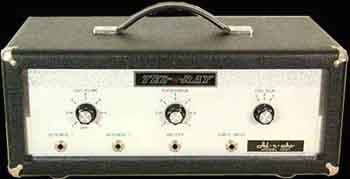
Of course, I didn't give this much thought until I inherited the early two-knob Ad-n-Echo pictured at the top of this page from a friend who comitted suicide in 1997.
He was a blues harmonica player, and I had heard him coax incredible Little Walter tones from this box whenever I had the pleasure of backing him up.
This page is dedicated to him.
Of course, I had no idea that this was the mysterious oilcan effect I had read about, I assumed it was a tape delay.
I had it sitting around for months before I bothered to turn it on. When I finally
got around to it, I noticed it didn't seem to do anything except boost the gain, so I opened up the back, expecting
to find a broken tape loop. Much to my surprise, what I saw looked like this.
The little rubber belt that turns the flywheel inside the oilcan had simply slipped off,
and seconds later I had the Ad-n-Echo up and running.
At last I had crossed paths with an oilcan delay.
The Ad-n-echo is a pretty big box...15.5" wide and 6" tall, and 8" deep, weighing close to 15lbs.
The front panel bears the words "TEL-RAY" and "Ad-n-echo",
and is outfitted with a red light, two chickenhead knobs, and three 1/4" jacks.
The chickenhead knob on the left of the panel controls what Tel-Ray called "Mode
Volume". In plain English, that would be "volume".
Apropriately enough, it goes from "1" to "7". No need for a "9" or "10" setting,
"7" will get you plenty of warbling Tel-Ray weirdness. Turned fully counter-clockwise,
the "Mode Volume" switches the Ad-n-echo off.
At the right is the three-way "Mode Selector" switch,
topped off with another chickenhead knob, offering a slow echo (Mode 1), fast
echo (Mode 2), and fast echo with more repeats (Mode 3).
If the Ad-n-echo has any shortcomings, I'd say it would be the lack of adjustable
delay time - you get slow or fast, that's it.
At the bottom of the front panel there are three jacks: "remote switch", "instrument", and "amplifer"...pretty self-explanatory.
The Tel-Ray's transformers, motor, oilcan, and single
7199 tube are hidden behind a panel at the rear of the unit which bears a small blue label.
It reads as follows:
